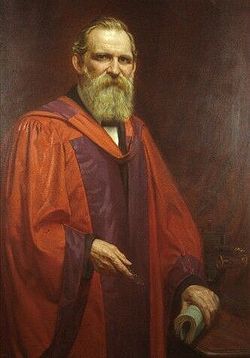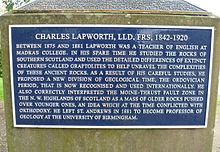- Charles Lapworth
-
Charles Lapworth (20 September 1842 – 13 March 1920) was an English geologist.
Contents
Biography
He was born at Faringdon in Berkshire (now Oxfordshire) and educated as a teacher at the Culham Diocesan Training College near Abingdon, Oxfordshire. He moved to the Scottish border region, where he investigated the previously little-known fossil fauna of the area. There in 1869 he married Janet, daughter of Galashiels schoolmaster Walter Sanderson and stayed in the area. Eventually, through patient mapping and innovative use of index fossil analysis, Lapworth showed that what was thought to be a thick sequence of Silurian rocks was in fact a much thinner series of rocks repeated by faulting and folding.
Charles Lapworth completed this pioneering research in the Southern Uplands while employed as a schoolmaster for 11 years at the Episcopal Church school, Galashiels. He then studied geology and became in 1875 an assistant at Madras College in St Andrews. Fife, and then in 1881 the first Professor of Geology at Mason's College, later the University of Birmingham, where he taught until his retirement.
He is best known for pioneering faunal analysis of Silurian beds by means of index fossils, especially graptolites, and his proposal (eventually adopted) that the beds between the Cambrian beds of north Wales and the Silurian beds of South Wales should be assigned to a new geological period: the Ordovician. This proposal resolved a long running controversy which began when Roderick Murchison and Adam Sedgwick argued over the relative ages of the strata in question. Lapworth received numerous awards for his research work, while for teaching he used the English Midlands as a setting for demonstrating the fieldwork techniques he had pioneered in his own research.
Following his researches in the Southern Uplands Charles Lapworth also devoted time to mapping near Durness in Scotland's northwest highlands and was first to propose the controversial theory that here older rocks were found lying above younger, suggesting complex folding or faulting as a cause. Later Peach and Horne were dispatched to the area and their monumental memoir proved Lapworth correct. In the English Midlands his research involved important work in Shropshire and the demonstration that Cambrian rocks underlay the Carboniferous rocks between Nuneaton and Atherstone.
His son Arthur Lapworth became a renowned chemist and his son Herbert a civil engineer, engineering geologist, stratigrapher and palaeontologist.
Honours and awards
Lapworth received many awards for his work and contributions to geology. In June 1888 he was elected a Fellow of the Royal Society and in 1891 was awarded their Royal Medal.[1] In 1899, he received the highest award of the Geological Society of London, the Wollaston Medal, in recognition of his outstanding work in the Southern Uplands, and Northwest Highlands of Scotland.
The glacial Lake Lapworth, was named for him by Leonard Johnston Wills in recognition of his original suggestion of its existence in 1898.[2]
Lapworth Museum
Papers relating to Charles Lapworth can be found at the University of Birmingham Special Collections. The University of Birmingham also maintains the Lapworth Museum within the Aston Webb building on the main Edgbaston campus. The Lapworth Archive, housed in the museum, contains a remarkably complete record of all areas of his research work and teaching.
References
- ^ "Library and Archive Catalogue". Royal Society. http://www2.royalsociety.org/DServe/dserve.exe?dsqIni=Dserve.ini&dsqApp=Archive&dsqCmd=Show.tcl&dsqDb=Persons&dsqPos=1&dsqSearch=%28Surname%3D%27lapworth%27%29. Retrieved 7 November 2010.
- ^ Wills, L.J. (1924). "The Development of the Severn Valley in the Neighbourhood of Iron-Bridge and Bridgnorth". Quarterly Journal of the Geological Society 80: 274–308. doi:10.1144/GSL.JGS.1924.080.01-04.15. http://jgslegacy.lyellcollection.org/content/80/1-4/274.abstract. Retrieved 27 August 2011.
External links
 Chisholm, Hugh, ed (1911). "Lapworth, Charles". Encyclopædia Britannica (11th ed.). Cambridge University Press.
Chisholm, Hugh, ed (1911). "Lapworth, Charles". Encyclopædia Britannica (11th ed.). Cambridge University Press.- "Eminent Living Geologists: Professor Charles Lapworth". Geological Magazine, New Series, Decade IV, VIII: 289–303. July 1901. http://books.google.com/books?id=9-JjAAAAIAAJ&pg=PA289.
20th century Jethro Teall · Charles Lapworth · John Marr · Archibald Geikie · William Sollas · William Watts · Aubrey Strahan · Arthur Smith Woodward · Alfred Harker · George Lamplugh · Richard Oldham · Albert Seward · John Evans · Francis Bather · John Gregory · Edmund Garwood · Thomas Holland · John Green · Owen Thomas Jones · Henry Hurd Swinnerton · Percy Boswell · Herbert Leader Hawkins · William Fearnsides · Arthur Trueman · Herbert Harold Read · Cecil Tilley · Owen Thomas Jones · George Lees · William King · Walter Campbell Smith · Leonard Hawkes · James Stubblefield · Sydney Hollingworth · Oliver Bulman · Frederick Shotton · Kingsley Dunham · Thomas Neville George · William Alexander Deer · Thomas Westoll · Percy Kent · Wallace Pitcher · Percival Allen · Howel Francis · Janet Watson · Charles Holland · Bernard Leake · Derek Blundell · Anthony Harris · Charles Curtis · (Robert) Stephen Sparks · Richard Hardman · Robin Cocks21st century Categories:- Presidents of the Geological Society of London
- 1842 births
- 1920 deaths
- People from Faringdon
- English geologists
- Royal Medal winners
- Wollaston Medal winners
- Fellows of the Royal Society
Wikimedia Foundation. 2010.


